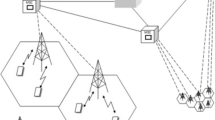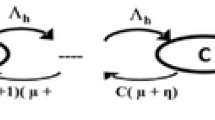Abstract
Handoff management has been an important but challenging issue in the field of wireless communication. It seeks to maintain seamless connectivity of mobile users changing their points of attachment from one base station to another. This paper derives a call admission control model and establishes an optimal step-size coefficient (k) that regulates the admission probability of handoff calls. An operational CDMA network carrier was investigated through the analysis of empirical data collected over a period of 1 month, to verify the performance of the network. Our findings revealed that approximately 23 % of calls in the existing system were lost, while 40 % of the calls (on the average) were successfully admitted. A simulation of the proposed model was then carried out under ideal network conditions to study the relationship between the various network parameters and validate our claim. Simulation results showed that increasing the step-size coefficient degrades the network performance. Even at optimum step-size (k), the network could still be compromised in the presence of severe network crises, but our model was able to recover from these problems and still functions normally.





Similar content being viewed by others
References
G. Boggia, P. Camarda, A. D’Arconzo, A. De Biasi, M. Siviero, Drop calls probability in established cellular network. From data analysis to modelling. Proc. IEEE Veh. Technol. Conf. 5, 2775–2779 (2005)
M. Yue, J.J. Han, K.S. Trivedi, Call admission control for reducing dropped calls in CDMA cellular systems. Comput. Commun. 25(7), 689–699 (2002)
B.L. Cragin, Prediction of seasonal trend in cellular dropped call probability. Proceedings of IEEE international conference on electro/information technology, East Lansing (2006), pp. 613–618
M. Ekpenyong, J. Isabona, Modeling the effect of dropped calls on cell traffic in established 3 g-based cellular networks. Afr. J. Comput. ICT 17(2), 157–164 (2014)
S. Guaguly, B. Nath, N. Goyal, Optimal bandwidth reservation schedule in cellular network. Proceeding of IEEE INFOCOM (2003)
N. Nasser, An acceptable trade-off between new call blocking and handoff call dropping probabilities in multimedia cellular network. Proceedings of IEEE 4th annual communication networks and service research conference (2006), pp. 1–5
Y. Iraqi, R. Baoutaba, Handoff and call dropping probabilities in wireless cellular networks. Proc. IEEE Int. Conf. Wirel. Netw. Commun. Mobile Comput. 1, 209–213 (2005)
S. Shilokawa, M. Ishizaka, Call admission scheme based on estimation of call dropping probability in wireless networks. Proc. IEEE Int. Symp. Pers. Indoor Mob. Radio Commun. Conf. 5, 2185–2188 (2002)
W. Ni, Optimal call admission policies in wireless cellular networks using semi markov decision process, Ph.D. Thesis, University of Toledo, Ohio (2008)
S. Chatziperis, P. Koutsakis, M. Paterakis, A new call admission control mechanism for multimedia traffic over next-generation wireless cellular networks. IEEE Trans. Mob. Comput. 7(1), 97–112 (2008)
J. Hou, Y. Fang, Mobility-based call admission control scheme for wireless mobile networks. Wirel. Commun. Mob. Comput. 1, 269–282 (2001)
M. Safwat, H. El-Badawy, A. Yehya, H. El-Motaafy, Analysis of different call admission control strategy and its impact on the performance of lTE-advanced network. Commun. Netw. 6, 137–154 (2014)
G.I. Tsiropoulos, D.G. Stratogiannis, H.H. Chen, P.G. Cottis, Utility-based probabilistic call admission control for complete fairness in wireless networks. Int. J. Commun Syst. 37(3), 521–528 (2014)
H. Tong, T.X. Brown, Reinforcement learning for call admission control and routing under quality of service constraints in multimedia networks. Mach. Learn. 49(2, 3), 111–139 (2002)
P. Garg, N. Goyal, Congestion control using modified Erlang’s loss formulae. Int. J. Eng. Res. Technol. 1(6), 1–3 (2012)
I. Angus, An introduction to Erlang B and Erlang C. Telemanag. Commun. 187, 6–8 (2001)
N. Hedge, K. Sohraby, Blocking in large cellular networks with bursty traffic. Proceedings of ACM SIGMETRICS, (2001), pp. 123–132
Author information
Authors and Affiliations
Corresponding author
Rights and permissions
About this article
Cite this article
Ekpenyong, M.E., Udoh, V.I. & Bassey, U.J. Mitigating Handoff Call Dropping in Wireless Cellular Networks: A Call Admission Control Technique. J. Inst. Eng. India Ser. B 97, 167–174 (2016). https://doi.org/10.1007/s40031-014-0170-4
Received:
Accepted:
Published:
Issue Date:
DOI: https://doi.org/10.1007/s40031-014-0170-4




